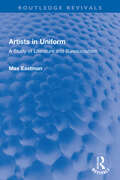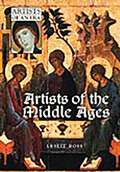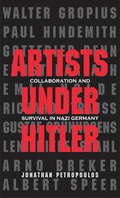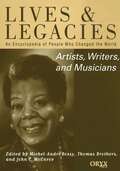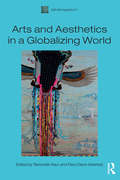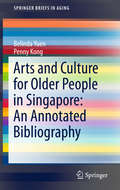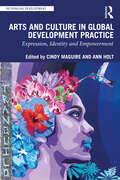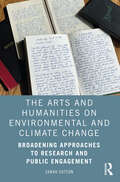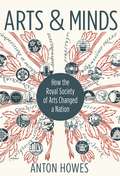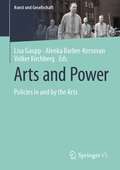- Table View
- List View
Artists in Uniform: A Study of Literature and Bureaucratism (Routledge Revivals)
by Max EastmanFirst published in 1934, Artists in Uniform confronts what the author describes as ‘two of the worst features of the Soviet experiment’ following Lenin’s death – bigotry and bureaucratism – and shows how they have functioned in the sphere of arts and letters. It is divided into three parts: The Artist’s International; A Literary Inquisition; and Art and the Marxian Philosophy.
Artists of the Middle Ages (Artists of an Era)
by Leslie D. RossIn the first volume of the Artists of an Era series, Leslie Ross examines the identities of artists attributed to the most famous and influential works of medieval art. These works are much discussed within the realm of art history, yet the identities of medieval artists fall victim to incomplete historical records and often remain enigmatic. In ten narrative chapters, Ross examines this significant area of the art world (including architecture, iconography, metalwork, scribework, sculpture—even medieval art instruction) and summarizes the lives and work of that genre's leading artist or artists.Students will learn not only what is factually known of an artist's life (as well as what is purely speculative), but also the processes used to gather the information and fuel speculation. Readers will also gain unique insights into the practices and traditions of medieval art and the role it played within medieval society. A timeline, chapter bibliographies, a list of further resources on medieval art, and an index offer additional tools to students of medieval art and art history.
Artists Under Hitler: Collaboration and Survival in Nazi Germany
by Jonathan Petropoulos“What are we to make of those cultural figures, many with significant international reputations, who tried to find accommodation with the Nazi regime?” Jonathan Petropoulos asks in this exploration of some of the most acute moral questions of the Third Reich. In his nuanced analysis of prominent German artists, architects, composers, film directors, painters, and writers who rejected exile, choosing instead to stay during Germany’s darkest period, Petropoulos shows how individuals variously dealt with the regime’s public opposition to modern art. His findings explode the myth that all modern artists were anti-Nazi and all Nazis anti-modernist. Artists Under Hitler closely examines cases of artists who failed in their attempts to find accommodation with the Nazi regime (Walter Gropius, Paul Hindemith, Gottfried Benn, Ernst Barlach, Emil Nolde) as well as others whose desire for official acceptance was realized (Richard Strauss, Gustaf Gründgens, Leni Riefenstahl, Arno Breker, Albert Speer). Collectively these ten figures illuminate the complex cultural history of Nazi Germany, while individually they provide haunting portraits of people facing excruciating choices and grave moral questions.
Artists, Writers, and Musicians: An Encyclopedia of People Who Changed the World (Lives and Legacies)
by Michel-André Bossy Thomas Brothers John C. McEnroeDisney's animated trailblazing, Dostoyevsky's philosophical neuroses, Hendrix's electric haze, Hitchcock's masterful manipulation, Frida Kahlo's scarifying portraits, Van Gogh's vigorous color, and Virginia Woolf's modern feminism: this multicultural reference tool examines 200 artists, writers, and musicians from around the world. Detailed biographical essays place them in a broad historical context, showing how their luminous achievements influenced and guided contemporary and future generations, shaped the internal and external perceptions of their craft, and met the sensibilities of their audience.
Arts Activities for Children and Young People in Need: Helping Children to Develop Mindfulness, Spiritual Awareness and Self-Esteem
by Diana CoholicArt-based activities can develop resilience and self-esteem, enabling children in need to cope better with ongoing stress and loss. Arts Activities for Children and Young People in Need offers interventions and exercises drawn from practice and research, for practitioners to use as a basis for their own arts-based groups or one-to-one sessions. Holistic arts activities facilitate a spiritually sensitive approach. Mindfulness-based exercises underpin the approach, and include guided meditations in which a group imagines that they are clouds, or draw feelings and emotions while listening to music, to encourage awareness of the senses. The activities help the group to relax and become more self-aware, encourage an exploration of feelings, values and understanding and are beneficial for children not ready to embrace traditional therapies or counselling. This book is accessible and suitable for helping, health and education practitioners and students from a variety of disciplines, such as social work, psychology and counselling.
Arts Activities for Children and Young People in Need: Helping Children to Develop Mindfulness, Spiritual Awareness and Self-Esteem (PDF)
by Diana CoholicArt-based activities can develop resilience and self-esteem, enabling children in need to cope better with ongoing stress and loss. Arts Activities for Children and Young People in Need offers interventions and exercises drawn from practice and research, for practitioners to use as a basis for their own arts-based groups or one-to-one sessions. Holistic arts activities facilitate a spiritually sensitive approach. Mindfulness-based exercises underpin the approach, and include guided meditations in which a group imagines that they are clouds, or draw feelings and emotions while listening to music, to encourage awareness of the senses. The activities help the group to relax and become more self-aware, encourage an exploration of feelings, values and understanding and are beneficial for children not ready to embrace traditional therapies or counselling. This book is accessible and suitable for helping, health and education practitioners and students from a variety of disciplines, such as social work, psychology and counselling.
Arts and Aesthetics in a Globalizing World (Association of Social Anthropologists Monographs)
by Raminder Kaur Parul Dave-MukherjiThis is an investigation of arts and aesthetics in their widest senses and experiences, presenting a variety of perspectives which range from the metaphysical to the political. Moving beyond art as an expression of the inner mind and invention of the individual self, the volume bridges the gap between changing perceptions of contemporary art and aesthetics, and maps globalizing currents in a number of contexts and regions.The volume includes an impressive variety of case studies offered by established leaders in the field and original and emerging scholarly talent covering areas in India, Nepal, Indonesia, Iran, Russia, Rwanda, and Germany, as well as providing transnational or diasporic perspectives. From the contradictory demands made on successful artists from the south in the global art world such as Anish Kapoor, to images of war and puppetry created by female political prisoners, the volume compels creative and political interpretations of the ever-changing and globalizing terrain of arts and aesthetics.
Arts and Aesthetics in a Globalizing World
by Raminder Kaur Parul Dave-MukherjiThis is an investigation of arts and aesthetics in their widest senses and experiences, presenting a variety of perspectives which range from the metaphysical to the political. Moving beyond art as an expression of the inner mind and invention of the individual self, the volume bridges the gap between changing perceptions of contemporary art and aesthetics, and maps globalizing currents in a number of contexts and regions.The volume includes an impressive variety of case studies offered by established leaders in the field and original and emerging scholarly talent covering areas in India, Nepal, Indonesia, Iran, Russia, Rwanda, and Germany, as well as providing transnational or diasporic perspectives. From the contradictory demands made on successful artists from the south in the global art world such as Anish Kapoor, to images of war and puppetry created by female political prisoners, the volume compels creative and political interpretations of the ever-changing and globalizing terrain of arts and aesthetics.
Arts and Aesthetics in a Globalizing World (Association Of Social Anthropologists Monographs)
by Raminder Kaur Parul Dave-MukherjiThis is an investigation of arts and aesthetics in their widest senses and experiences, presenting a variety of perspectives which range from the metaphysical to the political. Moving beyond art as an expression of the inner mind and invention of the individual self, the volume bridges the gap between changing perceptions of contemporary art and aesthetics, and maps globalizing currents in a number of contexts and regions.The volume includes an impressive variety of case studies offered by established leaders in the field and original and emerging scholarly talent covering areas in India, Nepal, Indonesia, Iran, Russia, Rwanda, and Germany, as well as providing transnational or diasporic perspectives. From the contradictory demands made on successful artists from the south in the global art world such as Anish Kapoor, to images of war and puppetry created by female political prisoners, the volume compels creative and political interpretations of the ever-changing and globalizing terrain of arts and aesthetics.
The Arts and Computational Culture: Real and Virtual Worlds (Springer Series on Cultural Computing)
by Jonathan P. Bowen Tula GianniniA Paradigm Shift and Defining Moment in the 21st Century: Fuelled by the convergence of computational culture, artificial intelligence, and machine learning, arts and culture are experiencing a revolutionary moment poised to change human life and society on a global scale. There is the promise of the Metaverse, with extended reality (XR) and immersive virtual worlds. For the first time, reality and virtuality are merging with these new developments. The proposed book is among the first to address the context, complexity, and impact of this multi-faceted subject in detail – for up close and personal engagement of the reader, while evoking a landscape view. As digital culture evolves to computational culture, we embark on a digital journey from 2D to 3D, where flat computer screens for the Internet and smart phones are evolving into immersive digital environments. This is while new technologies and AI are increasingly embedded in every aspect of daily life, the arts, and education.
Arts and Cultural Leadership in Asia (Routledge Advances in Asia-Pacific Studies)
by Jo CaustArts and cultural activity in Asia is increasingly seen as important internationally, and Asia’s growing prosperity is enabling the full range of artistic activities to be better encouraged, supported and managed. At the same time, cultural frameworks and contexts vary hugely across Asia, and it is not appropriate to apply Westerns theories and models of leadership and management. This book presents a range of case studies of arts and cultural leadership across a large number of Asian countries. Besides examining different cultural frameworks and contexts, the book considers different cultural approaches to leadership, discusses external challenges and entrepreneurialism, and explores how politics can have a profound impact. Throughout the book covers different art forms, and different sorts of arts and cultural organisations.
Arts and Cultural Leadership in Asia (Routledge Advances in Asia-Pacific Studies)
by Josephine CaustArts and cultural activity in Asia is increasingly seen as important internationally, and Asia’s growing prosperity is enabling the full range of artistic activities to be better encouraged, supported and managed. At the same time, cultural frameworks and contexts vary hugely across Asia, and it is not appropriate to apply Westerns theories and models of leadership and management. This book presents a range of case studies of arts and cultural leadership across a large number of Asian countries. Besides examining different cultural frameworks and contexts, the book considers different cultural approaches to leadership, discusses external challenges and entrepreneurialism, and explores how politics can have a profound impact. Throughout the book covers different art forms, and different sorts of arts and cultural organisations.
Arts and Culture for Older People in Singapore: An Annotated Bibliography (SpringerBriefs in Aging)
by Belinda Yuen Penny KongThis book combines in a single volume numerous studies concerning the use of arts and culture to enhance quality of life, health and wellbeing among older people, especially in Singapore. The bibliography covers not only research conducted in Singapore (both published and grey literature), but also a global body of work encompassing the Asia-Pacific region, Europe and North America. In addition to the annotated bibliography, the opening chapter introduces the current state of policy, practice and research on arts and culture for older people in Singapore. The book offers a valuable point of reference for all readers interested in the use of artistic and cultural development as creative and non-pharmacological approaches to providing support throughout the ageing process. It will be particularly useful for anyone interested in research advances in participatory arts therapies and recreational activities for older individuals.
Arts and Culture in Global Development Practice: Expression, Identity and Empowerment (Rethinking Development)
by Cindy Maguire and Ann HoltThis book explores the role that arts and culture can play in supporting global international development. The book argues that arts and culture are fundamental to human development and can bring considerable positive results for helping to empower communities and provide new ways of looking at social transformation. Whilst most literature addresses culture in abstract terms, this book focuses on practice-based, collective, community-focused, sustainability-minded, and capacity-building examples of arts and development. The book draws on case studies from around the world, investigating the different ways practitioners are imagining or defining the role of arts and culture in Belize, Canada, China, Ethiopia, Guatemala, India, Kosovo, Malawi, Mexico, Peru, South Africa, Sri Lanka, Taiwan, Thailand, the USA, and Western Sahara refugee camps in Algeria. The book highlights the importance of situated practice, asking what questions or concerns practitioners have and inviting a dialogic sharing of resources and possibilities across different contexts. Seeking to highlight practices and conversations outside normative frameworks of understanding, this book will be a breath of fresh air to practitioners, policy makers, students, and researchers from across the fields of global development, social work, art therapy, and visual and performing arts education.
Arts and Culture in Global Development Practice: Expression, Identity and Empowerment (Rethinking Development)
by Cindy Maguire Ann HoltThis book explores the role that arts and culture can play in supporting global international development. The book argues that arts and culture are fundamental to human development and can bring considerable positive results for helping to empower communities and provide new ways of looking at social transformation. Whilst most literature addresses culture in abstract terms, this book focuses on practice-based, collective, community-focused, sustainability-minded, and capacity-building examples of arts and development. The book draws on case studies from around the world, investigating the different ways practitioners are imagining or defining the role of arts and culture in Belize, Canada, China, Ethiopia, Guatemala, India, Kosovo, Malawi, Mexico, Peru, South Africa, Sri Lanka, Taiwan, Thailand, the USA, and Western Sahara refugee camps in Algeria. The book highlights the importance of situated practice, asking what questions or concerns practitioners have and inviting a dialogic sharing of resources and possibilities across different contexts. Seeking to highlight practices and conversations outside normative frameworks of understanding, this book will be a breath of fresh air to practitioners, policy makers, students, and researchers from across the fields of global development, social work, art therapy, and visual and performing arts education.
The Arts and Humanities on Environmental and Climate Change: Broadening Approaches to Research and Public Engagement
by Sarah SuttonThe Arts and Humanities on Environmental and Climate Change examines how cultural institutions and their collections can support a goal shared with the scientific community: creating a climate-literate public that engages with environmental issues and climate change in an informed way. When researchers, curators, and educators use the arts and humanities to frame discussions about environmental and climate change, they can engage a far wider public in learning, conversation, and action than science can alone. Demonstrating that archival and object-based resources can act as vital evidence for change, Sutton shows how the historical record, paired with contemporary reality, can create more personal connections to what many consider a remote experience: the changing climate. Providing valuable examples of museum collections used in discussions of environmental and climate change, the book shares how historic images and landscape paintings demonstrate change over time; and how documentary evidence in the form of archaeological reports, ships logs, Henry David Thoreau’s journals, and local reports of pond hockey conditions are being used to render climate data more accessible. Images, personal records, and professional documents have critical roles as boundary objects and proxy data. These climate resources, Sutton argues, are valuable because they make climate change personal and attract a public less interested in a scientific approach. This approach is underused by museums and their research allies for public engagement and for building institutional relevancy. The Arts and Humanities on Environmental and Climate Change will be most interesting to readers looking for ways to broaden engagement with environmental and climate issues. The ideas shared here should also act as inspiration for a broad spectrum of practitioners, particularly those writing, designing, and curating public engagement materials in museums, for wider research, and for the media.
The Arts and Humanities on Environmental and Climate Change: Broadening Approaches to Research and Public Engagement
by Sarah SuttonThe Arts and Humanities on Environmental and Climate Change examines how cultural institutions and their collections can support a goal shared with the scientific community: creating a climate-literate public that engages with environmental issues and climate change in an informed way. When researchers, curators, and educators use the arts and humanities to frame discussions about environmental and climate change, they can engage a far wider public in learning, conversation, and action than science can alone. Demonstrating that archival and object-based resources can act as vital evidence for change, Sutton shows how the historical record, paired with contemporary reality, can create more personal connections to what many consider a remote experience: the changing climate. Providing valuable examples of museum collections used in discussions of environmental and climate change, the book shares how historic images and landscape paintings demonstrate change over time; and how documentary evidence in the form of archaeological reports, ships logs, Henry David Thoreau’s journals, and local reports of pond hockey conditions are being used to render climate data more accessible. Images, personal records, and professional documents have critical roles as boundary objects and proxy data. These climate resources, Sutton argues, are valuable because they make climate change personal and attract a public less interested in a scientific approach. This approach is underused by museums and their research allies for public engagement and for building institutional relevancy. The Arts and Humanities on Environmental and Climate Change will be most interesting to readers looking for ways to broaden engagement with environmental and climate issues. The ideas shared here should also act as inspiration for a broad spectrum of practitioners, particularly those writing, designing, and curating public engagement materials in museums, for wider research, and for the media.
Arts and Minds: How the Royal Society of Arts Changed a Nation
by Anton HowesA major new history of the extraordinary society that has touched all aspects of British lifeFrom its beginnings in a coffee house in the mid-eighteenth century, the Royal Society for the Encouragement of Arts, Manufactures and Commerce has tried to improve British life in every way imaginable. It has sought to influence how Britons work, how they are educated, the music they listen to, the food they eat, the items in their homes, and even how they remember their own history. Arts and Minds is the remarkable story of an institution unlike any other—a society for the improvement of everything and anything.Drawing on exclusive access to a wealth of rare papers and artefacts from the Society's own archives, Anton Howes shows how this vibrant and singularly ambitious organisation has evolved and adapted, constantly having to reinvent itself to keep in step with changing times. The Society has served as a platform for Victorian utilitarian reformers, purchased and restored an entire village, encouraged the planting of more than sixty million trees, and sought technological alternatives to child labour. But this is more than just a story about unusual public initiatives. It is an engaging and authoritative history of almost three centuries of social reform and competing visions of a better world—the Society's members have been drawn from across the political spectrum, including Adam Smith, Edmund Burke, and Karl Marx.Informative and entertaining, Arts and Minds reveals how a society of public-spirited individuals tried to make their country a better place, and draws vital lessons from their triumphs and failures for all would-be reformers today.
Arts and Power: Policies in and by the Arts (Kunst und Gesellschaft)
by Lisa Gaupp Alenka Barber-Kersovan Volker KirchbergThe focus on concepts of power and domination in societal structures has characterized sociology since its beginnings. Max Weber’s definition of power as “imposing one’s will on others” is still relevant to explaining processes in the arts, whether their production, imagination, communication, distribution, critique or consumption. Domination in the arts is exercised by internal and external rulers through institutionalized social structures and through beliefs about their legitimacy, achieved by defining and shaping art tastes.The complexity of how the arts relate to power arises from the complexity of the policies of artistic production, distribution and consumption—policies which serve to facilitate or hinder an aesthetic object from reaching its intended public. Curators, critics and collectors employ a variety of forms of cultural and artistic communication to mirror and shape the dominant social, economic and political conditions.Arts and Power: Policies in and by the Arts brings together diverse voices who position the societal functions of art in fields of domination and power, of structure and agency—whether they are used to impose hegemonic, totalitarian or unjust goals or to pursue social purposes fostering equal rights and grassroots democracy. The contributions in this volume are exploratory steps towards what we believe can be a more systematic, empirically and theoretically founded sociological debate on the arts and power. And they are an invitation to take further steps.
